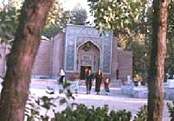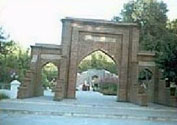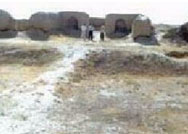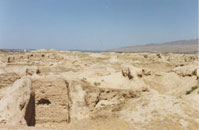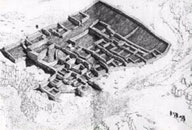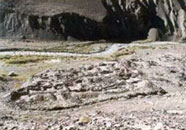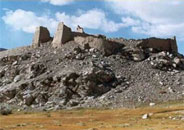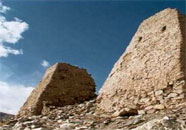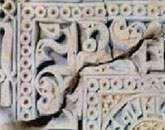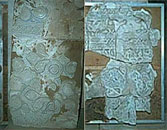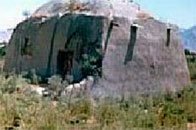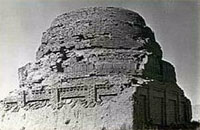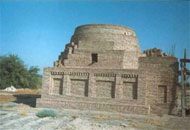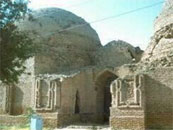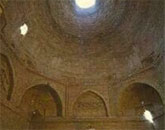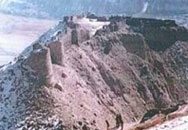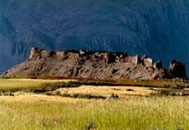

Historical places of Tajikistan |
Mausoleum Amir Said Hamadoni, XIV-XVII centuries
(Kulob)
It's a burial place of famous Persian-Tajik scientist, Mirsaid Khamadoni and his successors. He was known as the author of the books on philosophy, sophism, ethics, didactics. Mausoleum has a portal cupola structure with asymmetric plan. The building is made from the burnt brick on glue grout, and cupolas are made with alabaster grout. Central hall is covered by twin dome. Mausoleum was renovated several times. Researchers: S.G. Khmelnitsky (1985), A.M. Belinitsky (1958). The monument is restorated. The Kulob historical museum is setup here. (1995) Mausoleum is place of pilgrimage of Muslims and amateurs of history. gravestone Penjikent town V- VII centuries. Total area of town is 14 ha; the length of defensive walls is 2
km. Citadel with palace of ruler Devashticha was excavated, as well
as two fire temples with vast yards, eight main streets, ten lanes,
stores, workshops, markets and fortification walls. 150 many storied
and two and three storied dwelling houses, which belonged to different
groups of population were investigated. The materials are saved in the State Hermitage (Saint-Petersburg), Penjikent historico-archeological preserve (Penjikent city), in the fund of Institute of History (Dushanbe) Mausoleum "Muhammad Bashoro", XI-XII, XIV centuries
Bazar-Dara. The miners town, XI century. It was constructed during the exploitation of the silver deposits
in east Pamir in the period of "silver crisis" in Central
Asia. It is located on northern slopes of North Alichur range in
the valley of the Aq-Jilga river at 3980 m about the sea level.
Perspective of caravan-saray of Bazar-Dara
The town Kalai-Kahkaha or Bunjikant, the capital of Usturushan,
VII-IX centuries. Frescos, fragments of carving from the castle Kahkaha The walls of the palace halls were painted by miniature paintings:
scenes of battle, fiestas, and legends. In one of the wall there
was painted a wolf, feeding two babies. Wood columns, beams and
consoles were covered by superb carving of geometrical and flora
ornaments, scene compositions, images of people, animals, birds
and fantastic things. The town was strongly fortified and had good
conveniences. Despite the palace of Afshines it had residential
buildings for various groups of population, the temple of idols,
trade squares and ground. Excavations were held under the leadership
of Academic N.N. Negmatov (1955-1960, 1965-1972), Findings are preserved
in the National museum of Antiquity of the Republic of Tajikistan. It is situated on the right of bank of river Djaushangoz on rocky
ledge. It blocked the ways to the valley of the river Shah-dara
from the pass Mats and from the top of Tokuz-Bulak river. It is
surrounded by the defensive walls, which is fortified by the towers.
Houlbuk town , IX-XII centuries. 1.Khulbuk Palace Reconstruction Fragments of ceramic products with enamel IX-XII cc. Khulbuk
Mausoleum-mosque compound Khazrati Shoh, -XII centuries. Mosque Lailak, XI-XII centuries Kabadian region. Mosque with two cupolas and arches, constructed of raw bricks. It is a cult building, the place of worship, functioning at present time Researchers S.G. Khmelnitsky, A.M. Mukhtarov (1969)
Mausoleum Shoi Khomush, XI-XII centuries It's situated in Langar village. It has underground burial vault. The famous connoisseur of khadis is buried here. It is a place of pilgrimage of Muslims. The monument is renovated in 1994. Researchers: P.T. Samoilic (1985-1987) Sayed town, IX-XI centuries. Xl-XII centuries, 6 kilometres from the Saiyod village, is one
of the unique masterpieces of ancient architecture. It is unique
by its unusual planning, square outside and octagonal inside.
Mausoleum compound "Khodja Mashad" IX-XII centuries. It is the unique monument of the oriental architecture. It is located in Saiyod village in Shahritus region. That mausoleum was built in the X century, originally it had only one central building. The archaic elliptical, not lancet arches were preserved. In XI-XII centuries new dome-shaped building was adjoined to the mausoleum, with by the dense decorative arcade in the facade. This building was richly decorated by ornamented brickwork and terracotta fretwork in the style of Ismail Samanid mausoleum. The dome-shaped structure was connected with the first building by the portal, with the brick laid arch behind it. In the corners of the facade there are the towers-guldasta, and behind the mausoleum there were the vast yards with aivans and vaulted cells-hudjars. The compound "Khodja Mashhad" has the most ancient structure among all known medreses. Researchers: S.G. Khmelnitsky (1959 ), A.M. Belenitsky (1947 ), N.B. Nemtseva (1965) The monument needs renovation.
Mausoleum "Khoja Naqhshron", XI - XIII centuries. It is located in Tursunzoda. Mausoleum consists of two burials
in two premises, small and big mausoleum with the underground bureal
vault. In the middle there is a headstone. By plan it is square
with ruined cupola and portal. It was build in architectural method,
initiated in Khodja Mashhad .The splendid ornametal brickworks reaches
perfection, creating image of the refinement of the decorative colonnade.
It characterizes the achievement of Tajik architecture in XI- XII
centuries. Yamchun. Fortress, III-IBC - V-VII centuries. It is situated above the village Yamchun. It consists of the citadel
(on the top square) and is defended by the wall with parapet and
9 towers. The double line of walls surrounded the pace along the
slope. The walls are made from the stone, and are fortified by the
30 towers. It served as shelter for the population during the attack
of the enemy.
|
Copyright © 2004-2012 PAMIR TRAVEL
Made by: MabigaTeam
